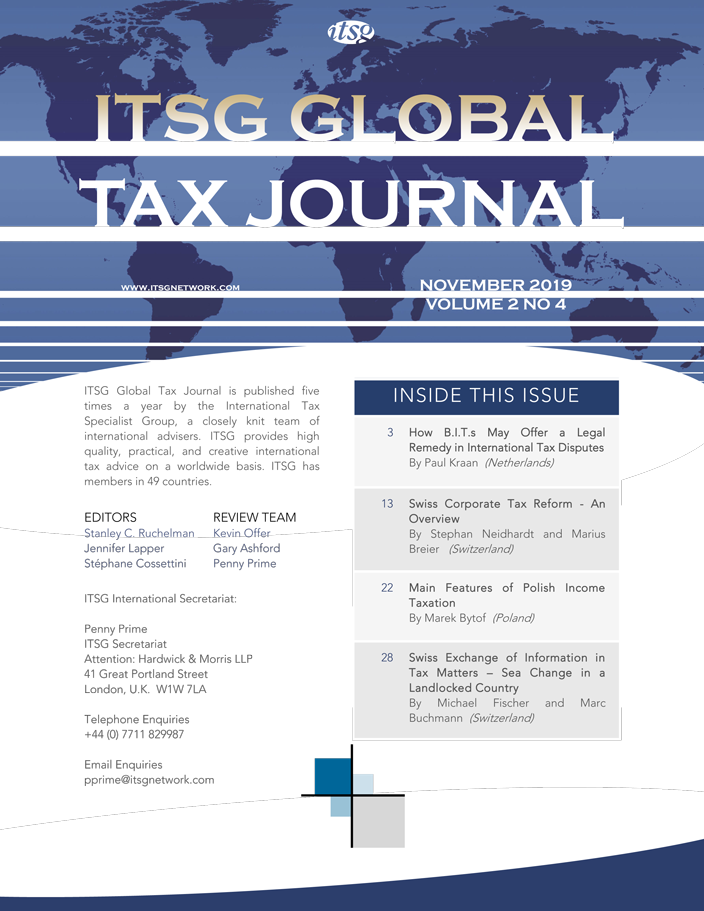GENERAL REMARKS
The Polish income tax landscape is deeply impacted by Poland’s membership in the O.E.C.D. and the E.U. The standards, rules, and laws of both organisations apply in Poland. To that end, Poland has signed the Multilateral Instrument (M.L.I.) which has revised many, but not all, of the 80 double tax treaties in force in a manner consistent with the O.E.C.D.’s B.E.P.S. Project. These include treaties with Australia, Austria, France, Israel, Japan, Slovakia, Slovenia, and the U.K. On the other hand, several treaties will not be modified by the M.L.I. Included in this category are tax treaties with the Netherlands, Germany, and the United States. Beyond the M.L.I., B.E.P.S. standards have been transposed into the local tax environment, and the ongoing process of implementing E.U. legislation is underway, recently focussing on anti-tax avoidance directives such as A.T.A.D. and DAC6.
BASIC INTERNAL TAX CONCEPTS
Internally, Polish tax law contains two separate sets of income tax rules. One covers the income of individuals and another covers the income of legal entities and partnerships that are limited by shares (Corporate Partnerships). Other partnerships are fiscally transparent.
The personal and corporate income tax regimes contain similar constructive assumptions.
Residence
All taxpayers, whether individuals or entities, are subject to tax on a worldwide basis if they meet a residency test.
Individuals are regarded as Polish tax residents if they are present in Poland for more than 183 days per year or if their centre of vital interests is located in Poland, as detailed in the case law. On the other hand, all legal entities (and Corporate Partnerships) are regarded as local tax residents if their registered seat or place of management is in Poland.
Tax rates
For individuals, a rate of 18% is applicable to income up to a threshold that equates to approximately €19,600. Income in excess of that amount is subject to tax at a rate of 32%. There are relatively low levels of direct deductions for an individual when computing taxable income. These are so-called free-of-tax amounts. Self-employed individuals may choose to be taxed at a 19% flat rate with no threshold. A new, effective from August 2019, revision to Polish tax law will provide a exemption from tax for individuals up to the age of 26 years. In addition, for certain activities, lump sum rates are also available, with the rates ranging from 2% to 20%.
For corporations and Corporate Partnerships, the regular income tax rate is 19%. A reduced 9% rate is available for small corporations and Corporate Partnerships. Entities with pre-tax income not exceeding the equivalent to €1,200,000 per year benefit from the exemption. Withholding tax on dividends is 19%. Note that exemptions provided by double tax treaties or the E.U. Parent-Subsidiary Directive are not taken into account in determining whether the ceiling on the 9% rate is exceeded.
Dividend payments
Corporate taxpayers that distribute dividends of up to approximately €460,000 must ensure they are not involved in fully artificial structures, created mainly for the purpose of tax avoidance. Taxpayers paying out dividends over the threshold must deduct refundable withholding tax, imposed at the rate of 19%. A shareholder entitled to tax-free treatment under a treaty or the E.U. Parent-Subsidiary Directive may apply for a full refund of the withheld tax.
An option exists for intercompany dividends to be paid without any withholding tax. However, the benefit is allowed only where a prior ruling is obtained from the tax administration, known as the K.A.S. To benefit from the non-deduction, the taxpayer must give a formalised declaration to the tax administration stating the facts and circumstances and explaining why the exemption from withholding tax is applicable. However, the system is complex and withholding tax on dividends in excess of the equivalent of approximately €460,000 is suspended through the end of 2019.
Losses
For individuals, corporations, and Corporate Partnerships, losses may be carried forward for up to five years. During the carryover period, not more than 50% of the losses may be deducted in any single year during the carryover period.
RULES TO COMBAT AGGRESSIVE TAX PLANNING
In recent years, the Polish tax system has been reshaped to counteract aggressive tax planning via wholly artificial domestic and international structures.
General Anti-Avoidance Rule
On 15 July 2016, the new General Anti-Avoidance Rule (G.A.A.R.) came into force.
Based on an O.E.C.D. concepts, the G.A.A.R. authorizes the K.A.S. to determine a taxpayer’s position without taking into account any artificial or contrived arrangements intended to gain artificial tax advantages that are contrary to the object and purpose of tax law. Under the G.A.A.R., the tax consequences are determined according to the transactions that would have been performed if the taxpayer had acted appropriately. In broad terms, appropriate activity connotes that the taxpayer does not act in an artificial manner and has commercial grounds for entering the transactions. Stated somewhat differently, it means that a transaction was entered into not simply to obtain a tax advantage. If a transaction is disregarded under the G.A.A.R. rules, additional tax may be imposed, and because it is paid late, interest will be due in connection with the initial underpayment. As a consequence of any such re-classification, the taxpayer may be charged late-payment interest on tax deficiencies arising from the application of the G.A.A.R.
Absence of cases
It has been three years since the G.A.A.R. entered into force. During this period, no cases have been published providing guidance on the practical application of the rule. As a result, the Polish G.A.A.R., which uses ill-defined terms such as ‘artificial’, ‘contrived’, ‘tax advantage’, and ‘commercial grounds’, provides more uncertainty than it resolves. Even a fair entrepreneur who pays taxes and fulfils all requirements cannot be sure that the tax authorities will not question his or her activities in the future and impose additional taxes and interest.
To illustrate, the practical understanding of the term ‘tax advantage’ is not clear. Theoretically, the term covers each of the following:
- a failure to determine the tax liability,
- a delay in determining the tax liability,
- a reduction of the amount of tax,
- an overestimation of losses, and
- obtaining an excessive tax refund.
All of these are referred to as tax advantages in the Polish G.A.A.R. laws, yet they may not arise for an abusive intent as to the amount of Polish tax due and payable from a transaction. In many cases, the tax advantage may simply result from different understandings of one or more relevant business-related facts. In illustration, an individual may choose to take advantage of the 8.5% lump sum tax rate on rental income. It is clear that the individual has elected lump sum tax to avoid paying greater tax. There is no commercial purpose but tax reduction. Yet it is clear to most sane persons that the ability to choose to pay a lower tax was precisely what the Polish parliament intended when the relevant tax provision was enacted into law.
Regrettably, little comfort can be derived from a legal definition of the ‘artificial manner of obtaining tax advantages’ as no limits or qualifications are placed on its applications. A rational person might look to the following factors as a prerequisite for applying the G.A.A.R. to a particular transaction:
- unjustified division of the transaction,
- unjustified economic involvement by third parties,
- lack of economic and business justification for entering a business transaction,
- appearance of elements leading to the same or similar position to the one existing before an activity took place,
- appearance of elements which annul or offset each other, and
- the extent to which an entity would not reasonably choose such mode of action
These abusive situations generally can be demon strated within day-to-day business operations. An exemption until the end of December 2019 provides that the G.A.A.R. will not be applied to transactions that do not exceed the equivalent of approximately €23,000 per year.
Material on Ministry of Finance website
Some clarifying material is published on the Ministry of Finance website. Mostly, the material consists of tax warnings, published only in Polish, which are not legally binding but show the general views of the K.A.S.
At present, the tax warnings refer to wholly artificial arrangements involving private investment funds or shelf companies. These broadly follow decisions issued on 26 February 2019 by the Court of Justice of the E.U. in the so-called Danish Cases.
Protective opinions
In these circumstances, the ‘protecting opinion’ has been introduced as a way of obtaining legal protection for planned operations that may be subject to the G.A.A.R. A request is submitted to the K.A.S. and is quite similar to a request for a tax ruling. The request should explain the factual background, planned operations, business and economic justification, tax implications, and the taxpayer’s own view as to the reasons why the G.A.A.R. is not applicable. The fee charged by the K.A.S. is the equivalent of approximately €4,500, which is a relatively high amount for start-up companies. As a result, not many protecting opinions have been issued as taxpayers are not keen to pay the fee. Nonetheless, the protecting opinion is the only solution for entrepreneurs who wish to be sure that business activities will not be contested under G.A.A.R.
Mandatory Disclosure Rules
Aggressive scope
The Mandatory Disclosure Rules (M.D.R.) constitute another instrument aimed at combating artificial structuring. On the 26 October 2018, the Polish parliament adopted an act transposing the Council of the European Union Directive 2018/822 of 25 May 2018. This is an amendment to Directive 2011/16/E.U. with respect to mandatory automatic exchange of information in the field of taxation in relation to reportable cross-border arrangements (DAC6). It entered into force in the Polish tax system on 25 June 2018.
The Polish parliament chose a very aggressive approach in transposing DAC6. First, implementation was significantly accelerated. The measures entered into force on 1 January 2019, instead of 1 July 2020 as specified in DAC6. In addition, the M.D.R. applies retroactively and is effective from 25 June 2018. Second, the Polish M.D.R. legislation is much wider in scope compared to DAC6. It embraces expanded coverage of reportable tax arrangements that includes wholly domestic tax arrangements and V.A.T. Thus, it goes beyond the cross-border scope of DAC6.
Persons covered
There are two categories of persons covered by the M.D.R. rules: users and promoters. A user is a natural or legal person, or an organisational unit that does not have legal personality:
- to whom the arrangement is made available,
- in whose enterprise the arrangement is being implemented, or
- who is prepared for the implementation or who has taken a step to implement the arrangement.
A promoter is an adviser obliged to disclose the scheme. A promoter may be:
- a natural,
- a legal person,
- an organisational unit that does not have legal personality,
- a tax adviser,
- an attorney at law, or
- an employee of a bank or another financial institution.
As a catchall, a promoter may be another person who performs services, is not listed above, but who has similar qualifications to those listed above.
Hallmarks of tax avoidance
The Polish M.D.R. sets out 24 hallmarks that indicate a potential risk of tax avoidance. DAC6 provides 15 hallmarks. Only 11 of the 24 hallmarks require the existence or suspicion of a tax benefit. The others must be reported even if no tax plan or benefit is involved. Where the M.D.R. applies, reporting is required within 30 days from the date of sharing the scheme or implementing the advice.
Triggers for mandatory reporting within the 30-day time limit include:
- The promoter or user undertakes to abide by a confidentiality clause beyond the standard profes sional confidentiality rules within a profession.
- The fee is fixed by reference to the amount of the tax advantage derived from the arrangement.
- The documentation or form of the arrangement is significantly harmonised so that it is identical or nearly identical with documents in compara ble schemes offered to other taxpayers.
- The scheme results in a change in the classification of income or tax rules applicable to the transaction, resulting in a lower tax rate, tax relief, or tax exemption.
- There has been a circular flow of cash as part of the scheme.
- Cross-border payments have been made to an associated enterprise based in a low-tax country, reducing Polish taxes.
- The user has undertaken to co-operate with the promoter who designs the arrangement.
Tax scheme numbers, penalties, and guidance
After submission of the report, a ‘tax scheme number’ is issued. The Ministry of Finance has stated that, from the beginning of 2019 until 10 July 2019, promoters have submitted 3,341 reports while only 272 tax scheme numbers were granted. This shows how complicated and unclear the process may be and that the pace of the tax authorities is slow.
Failure to report or other non-compliance may result in the imposition of fines of up to the equivalent of approximately €2,333,300 for a promoter and up to the equivalent of approximately €5,040,000 for a user.
The biggest concern in the Polish implementation of the M.D.R. regulations is their application. Open questions exist as to which persons have the status of a promoter, which arrangements should be reported, and whether an intermediary has a duty to investigate arrangements that are not originated by the taxpayer.
The Polish Ministry of Finance has issued official guidelines containing 100 pages of practical tips on the proper way to comply with the M.D.R. regulations. The guidelines have a significant impact as they give legal protection to those who follow ministerial recommendations. Unfortunately, the guidelines are available in Polish only. They can be downloaded from the Ministry’s website.
Exit tax for corporations and individuals
The exit tax is perhaps the most controversial of the new anti-avoidance measures adopted by the Polish parliament. The exit tax was introduced in internal tax laws on 1 January 2019, following the E.U. A.T.A.D. provisions. However, the local approach is significantly broader than the original E.U. concept. While the scope of the E.U. directive is limited to entities subject to corporate income tax, the Polish version also covers individuals. This has led to doubts as to whether the exit tax regulations are in accordance with E.U. law.
The regular rate of exit tax on entities subject to corporate tax is 19%. The rate for individuals is 19% or 3% depending on whether they are entitled to deduct costs (higher rate applies) or they not entitled to deduct costs (lower rate applies). Individuals are not chargeable if the fair market value of their assets does not exceed the equivalent of approximately €920,000.
For individuals, the exit tax arises only on financial assets and assets connected with business activities. Substantial questions exist in quantifying real estate assets for exit tax purposes. No guidance exists in determining when ownership of real estate assets is connected with the conduct of a business. If activities in managing the asset are relatively few and the ownership is passive, is it nonetheless a business? When is real estate merely an investment activity that produces an annual return in the form of rents? Official clarification has been promised by the Ministry of Finance. It is expected that whenever issued, guidance will be provided.
Controlled Foreign Company legislation
Controlled Foreign Company (C.F.C.) rules have been in effect in Poland from January 2015. From January 2019, the C.F.C. rules have been expanded to cover Controlled Foreign Entities (C.F.E.) and Controlled Foreign Arrangements (C.F.A.). Hence, the C.F.C. rules cover not only companies but also trusts, foundations, groups of companies, and any legal relationship having fiduciary features.
The applicable tax rate is 19% of the taxable base. Many different types of passive income fall within the C.F.C. rules, including income derived from dividends, shares, debts, royalties, and rents. If a company (or arrangement) derives at least 33% of its income from passive assets and a Polish resident taxpayer owns directly or indirectly an equity interest representing at least 50% of the voting rights within the entity, the entity is a C.F.C. In addition, all structures located in a harmful jurisdiction or a jurisdiction that does not have a comprehensive tax treaty with Poland in effect are also regarded as C.F.C.s, no matter the nature of their income.
The company (or arrangement) will not be regarded as a C.F.C. if it carries out actual business activities. A combination of objective circumstances should be used to determine whether the business is real or devoid of any economic and commercial purpose. Under the law, the company must have sufficient substance to objectively prove its business activity. Substance means office space, qualified personal, proper equipment, etc.
Contrary to G.A.A.R. or M.D.R. regulations, tax rulings may be obtained from the K.A.S. regarding the scope of the C.F.C. rules on a foreign entity. At present, no disputes or case law exists under the C.F.C. rules, and no Polish taxpayers are known to be under investigation regarding the status of entities owned outside of Poland.
CONSTITUTION FOR BUSINESS
While the foregoing discussion illustrates the proliferation of anti-avoidance rules enacted in recent years, many tax planning opportunities continue to exist. For example, the Polish parliament recently approved a governmental package of laws called the Constitution for Business. Some have referred to it as the most significant reform of Polish commercial law since the end of the communist regime. Among the new business friendly acts are:
- Entrepreneurs Law Act intended to promote co-operation between the state’s
- administration and entrepreneurs
- Act on Ombudsman for Small and Medium-sized Entrepreneurs intended to provide helpful advice to small and medium-sized businesses, eliminating risk, and reducing costs
- Act on the rules for participation of foreign entrepreneurs and other foreign persons in trade
- on the territory of the Republic of Poland, intended to prevent surprise application of laws
INTELLECTUAL PROPERTY BOX REGIME
One specific tax related act that that is intended to provide tax benefits is the Intellectual Property (I.P.) Box Regime. The purpose of this measure is to provide a new business-friendly environment for innovative activities. The main feature of the Polish I.P. Box Regime is a preferential 5% tax rate applied to qualified income obtained from certain I.P. rights created, developed, or acquired and improved by a taxpayer. The qualifying I.P. rights include among other the following items:
- patents
- extensions of patent protection
- extensions of patent protection for medicinal products and plant protection products
- registered medicinal and veterinary products admitted to trading
- software
Qualified income covers fees and royalties derived under license agreements covering qualifying I.P. rights and income from direct sale of such rights.
The Polish I.P. Box Regime meets O.E.C.D. standards. Taxpayers planning to benefit from the regime must fulfil additional documentation requirements. These include a requirement to maintain accounting records that allow for the identification of each qualifying I.P. right and the determination of revenues, tax deductible costs, and income or loss attributable to that right. Nonetheless, the Polish I.P. Box regulations are broader and more flexible than those that exist in certain other jurisdictions.
The Ministry of Finance recently issued guidelines stating that the new I.P. Box Regime may be combined with pre-existing relief for research and development (R&D) activities. Bearing in mind that R&D relief makes it possible for a 100% or, in some situations, 150% deduction, the regime is quite advantageous.
CONCLUSION
In sum, investing in Poland comes with both pitfalls and rewards. Poland is zealously committed to compliance and transparency, at times going beyond the efforts of its O.E.C.D. and E.U. counterparts. This fervour is expected to decrease the likelihood that Polish measures will be challenged by the European Commission. At the same time, the government has adopted measures that appeal to investors, particularly with the recent introduction of the Constitution for Business and the I.P. Box Regime.

 Login
Login





















































